Granadilla
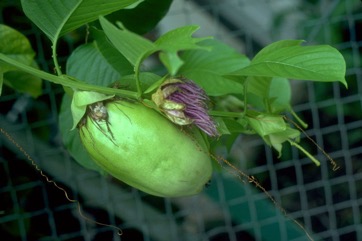
A tropical plant. It mainly occurs in the tropical lowlands but grows up to about 1000 m. It suits hot humid lowland areas in the tropics. Fruiting is often best between 200-500 m altitude. They can stand cool temperatures when mature. At 21-26°C seed germinate in 1-2 weeks but at lower temperatures seed can take 10 weeks. It suits hardiness zones 10-12. In XTBG Yunnan.
Also known as:
Akar mentimun, Aka-wadi, Badea, Barbadine, Barbajina, Belewa, Chum bao dua, Corvejo, Dua gang tay, Erbis, Gendola, Giant granadilla, Granadilla de fresco, Granadilla grande, Granadilla real, Jujo, Karora chi, Kasaflora, Manesa, Maracuya real, Markiza, Markoesa, Marquesa, Masaflula, Mentimun, Misriphal, Panthao milao, Parcha, Percha granadina, Qaranidila, Sao warot, Sapthailempa, Sukhontharot, Taeng kalaa, Telur dewa, Thaloi, Timun belanda, Timun hatan, Tambo, Tumbo
Synonyms
- Passiflora macrocarpa Mast.
- Passiflora quadrangularis var. variegata
- Passiflora tetragona
Edible Portion
- Fruit, Seeds, Vegetable, Root
Where does Granadilla grow?
Found in: Africa, Amazon, Asia, Australia, Bangladesh, Bolivia, Brazil, Cambodia, Cameroon, Central Africa, Central America, China, Colombia, Congo DR, Cook Islands, Costa Rica, Cuba, Dominican Republic, East Africa, East Timor, Ecuador, El Salvador, Fiji, Ghana, Guiana, Guianas, Guinea-Bissau, Guyana, Haiti, Hawaii, India, Indochina, Indonesia, Jamaica, Madagascar, Malawi, Malaysia, Marquesas, Mexico, Mozambique, Myanmar, New Caledonia, Nicaragua, Northeastern India, Pacific, Palau, Papua New Guinea, PNG, Peru, Philippines, Puerto Rico, Rotuma, Sao Tome and Principe, SE Asia, Sierra Leone, Solomon Islands, South America, Sri Lanka, Suriname, Taiwan, Thailand, Timor-Leste, Tonga, Uganda, Vanuatu, Venezuela, Vietnam, West Africa, West Indies, West Papua, Zimbabwe
Notes: There are about 400 Passiflora species.
Status: Reasonably common in lowland areas in Papua New Guinea.
Growing Granadilla
Cultivation: Plants are normally grown from cuttings but they can be grown from seed. Cuttings 25- 30 cm long from well matured stems should be used. A spacing of 2-3 m between plants is suitable. It needs a trellis to grow over. It often pays to hand pollinate. Seed germinate in 2-4 weeks. Seedlings can be planted in the field within 4 months.
Edible Uses: Sometimes unripe fruit is boiled as a vegetable. It can be used in soups. It can be cut in pieces and cooked in butter with pepper and nutmeg. Otherwise the fruit is eaten ripe. It can be used for juice, fruit salad, pies, jellies, cold drinks sauces and wines. Sometimes the swollen root is cooked and eaten like a yam. CAUTION The leaves are poisonous.
Production: The vine is fast growing. A vine lasts for 5-6 years. Flowers are produced 9 months from planting. Fruit are ready to harvest 60-80 days from flowering. A vine can produce 16-50 fruit in a season.
Nutrition Info
per 100g edible portion| Edible Part | Energy (kcal) | Protein (g) | Iron (mg) | Vitamin A (ug) | Vitamin c (mg) | Zinc (mg) | % Water |
|---|---|---|---|---|---|---|---|
| Seed & aril | 81 | 1.9 | 2.9 | - | 15 | - | 78.4 |
| Fruit - flesh only | 41 | 0.7 | 0.8 | - | 15 | - | 94.4 |
Granadilla Photos

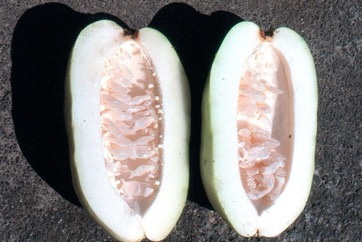
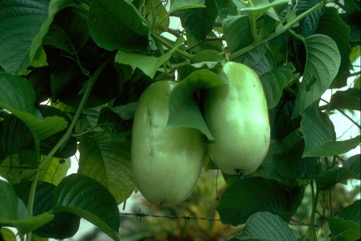
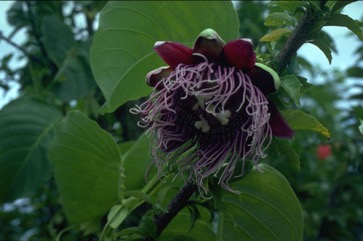
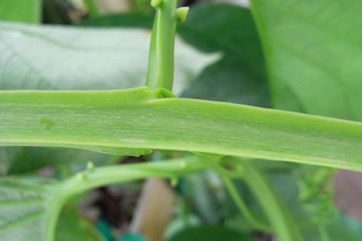
References
Abbiw, D.K., 1990, Useful Plants of Ghana. West African uses of wild and cultivated plants. Intermediate Technology Publications and the Royal Botanic Gardens, Kew. p 42
Ambasta, S.P. (Ed.), 2000, The Useful Plants of India. CSIR India. p 434
Anderson, E. F., 1993, Plants and people of the Golden Triangle. Dioscorides Press. p 217
Arora, R. K., 2014, Diversity in Underutilized Plant Species - An Asia-Pacific Perspective. Bioversity International. p 80
Asprilla-Perea, J., & Diaz-Puente, J.M., 2018, Traditional use of wild edible food in rural territories within tropical forest zones: A case study from the northwestern Colombia. New Trends and Issues Proceedings on Humanities and Social Sciences [Online]. 5(1), 162–181.
Bodkin, F., 1991, Encyclopedia Botanica. Cornstalk publishing, p 765
Bodner, C. C. and Gereau, R. E., 1988, A Contribution to Bontoc Ethnobotany. Economic Botany, 43(2): 307-369
Bourke, R. M., Altitudinal limits of 230 economic crop species in Papua New Guinea. Terra australis 32.
Bourret, D., 1981, Bonnes-Plantes de Nouvelle-Caledonie et des Loyaute. ORSTOM. p 55
Brickell, C. (Ed.), 1999, The Royal Horticultural Society A-Z Encyclopedia of Garden Plants. Convent Garden Books. p 756
Burkill, H. M., 1985, The useful plants of west tropical Africa, Vol. 4. Kew.
Burkill, I.H., 1966, A Dictionary of the Economic Products of the Malay Peninsula. Ministry of Agriculture and Cooperatives, Kuala Lumpur, Malaysia. Vol 2 (I-Z) p 1705
Castaneda, H., & Stepp, J. R., 2007, Ecosystems as Sources of Useful Plants for the Guaymi People of Costa Rica. Ethnobotany Journal. 5:249-257
Cheifetz, A., (ed), 1999, 500 popular vegetables, herbs, fruits and nuts for Australian Gardeners. Random House p 215
Coe, F. G. and Anderson, G. J., 1999, Ethnobotany of the Sumu (Ulwa) of Southeastern Nicaragua and Comparisons with Miskitu Plant Lore. Economic Botany Vol. 53. No. 4. pp. 363-386
Coronel, R.E., 1982, Fruit Collections in the Philippines. IBPGR Newsletter p 8
Cundall, P., (ed.), 2004, Gardening Australia: flora: the gardener's bible. ABC Books. p 991
Darley, J.J., 1993, Know and Enjoy Tropical Fruit. P & S Publishers. p 96
Etkin, N.L. (Ed.), 1994, Eating on the Wild Side, Univ. of Arizona. p 157
Facciola, S., 1998, Cornucopia 2: a Source Book of Edible Plants. Kampong Publications, p 167
Flora of Australia, Volume 8, Lecythidales to Batales, Australian Government Publishing Service, Canberra (1982) p 154
Flowerdew, B., 2000, Complete Fruit Book. Kyle Cathie Ltd., London. p 136
French, B.R., 1986, Food Plants of Papua New Guinea, A Compendium. Asia Pacific Science Foundation p 258
French, B.R., 2010, Food Plants of Solomon Islands. A Compendium. Food Plants International Inc. p 249
Gillaumin, R., 1954, Les Plantes utiles des Nouvelles-Hebrides (fin et complement) In: Journal d'agriculture tropicale et de botanique appliquee Vol. 1, No. 10-12 pp 453-460
Gouldstone, S., 1983, Growing your own Food-bearing Plants in Australia. Macmillan p 114
Grubben, G. J. H. and Denton, O. A. (eds), 2004, Plant Resources of Tropical Africa 2. Vegetables. PROTA, Wageningen, Netherlands. p 563
Hedrick, U.P., 1919, (Ed.), Sturtevant's edible plants of the world. p 467 (Also as Passiflora macrocarpa)
Hermandez Bermejo, J.E., and Leon, J. (Eds.), 1994, Neglected Crops. 1492 from a different perspective. FAO Plant Production and Protection Series No 26. FAO, Rome. p16
Hibbert, M., 2002, The Aussie Plant Finder 2002, Florilegium. p 220
http://palaeoworks.anu.edu.au/Nuno_PhD/04.pdf re Timor
http://www.botanic-gardens-ljubljana.com/en/plants
Jardin, C., 1970, List of Foods Used In Africa, FAO Nutrition Information Document Series No 2.p 153
Katende, A.B., Birnie, A & Tengnas B., 1995, Useful Trees and Shrubs for Uganda. Identification, Propagation and Management for Agricultural and Pastoral Communities. Technical handbook No 10. Regional Soil Conservation Unit, Nairobi, Kenya. p 482
Kapelle, M., et al, 2000, Useful plants within a Campesino Community in a Costa Rican Montane Cloud Forest. Mountain Research and Development, 20(2): 162-171
Kiple, K.F. & Ornelas, K.C., (eds), 2000, The Cambridge World History of Food. CUP p 1777
Langlois, H. C., 2004, Ethnobotanical analysis of different successional stages as sources of wild edible plants for the Guaymi people in Costa Rica. M. Sc. thesis University of Florida.
Latham, P., 2004, Useful Plants of Bas-Congo province. Salvation Army & DFID p 214
Lazarides, M. & Hince, B., 1993, Handbook of Economic Plants of Australia, CSIRO. p 184
Lembaga Biologi Nasional, 1977, Buah-Buahan, Balai Pustaka, Jakarta. p 36
Lim, T. K., 2015, Edible Medicinal and Non Medicinal Plants. Volume 9, Modified Stems, Roots, Bulbs. Springer p 63
Llamas, K.A., 2003, Tropical Flowering Plants. Timber Press. p 310
Lord, E.E., & Willis, J.H., 1999, Shrubs and Trees for Australian gardens. Lothian. p 336
Lorenzi, H., Bacher, L., Lacerda, M. & Sartori, S., 2006, Brazilian Fruits & Cultivated Exotics. Sao Paulo, Instituto Plantarum de Estuados da Flora Ltda. p 272
Lyle, S., 2006, Discovering fruit and nuts. Land Links. p 315
Macmillan, H.F. (Revised Barlow, H.S., et al) 1991, Tropical Planting and Gardening. Sixth edition. Malayan Nature Society. Kuala Lumpur. p 305
Martin, F. W., et al, 1987, Perennial Edible Fruits of the Tropics. USDA Handbook 642 p 51
Menninger, E.A., 1977, Edible Nuts of the World. Horticultural Books. Florida p 120
Miguel, E., et al, 1989, A checklist of the cultivated plants of Cuba. Kulturpflanze 37. 1989, 211-357
Morley, B. & Everard, B., 1970, Wild Flowers of the World. Ebury press. Plate 173
Morton, J. F., 1987, Fruits of Warm Climates. Wipf & Stock Publishers p 328
Norrington, L., & Campbell, C., 2001, Tropical Food Gardens. Bloomings Books. p 102
Ochse, J. J. et al, 1931, Vegetables of the Dutch East Indies. Asher reprint. p 580
Omawale, 1973, Guyana's edible plants. Guyana University, Georgetown p 21
Partha, P., 2014, Ethnobotany of the Laleng (Patra) Community in Bangladesh. Journal of Pharmacognosy and Phytochemistry. 2(6):173-184
Pasha, M. K. & Uddin, S. B., 2019, Minor Edible Fruits of Bangladesh. Bangladesh J. Plant Taxon. 26(2): 299–313
Paz, F. S., et al, 2021, Edible Fruit Plant Species in the Amazon Forest Rely Mostly on Bees and Beetles as Pollinators. Journal of Economic Entomology, XX(XX), 2021, 1–13
Peekel, P.G., 1984, (Translation E.E.Henty), Flora of the Bismarck Archipelago for Naturalists, Division of Botany, Lae, PNG. p 387, 386
Pham-Hoang Ho, 1999, An Illustrated Flora of Vietnam. Nha Xuat Ban Tre. p 556
Plants of Haiti Smithsonian Institute http://botany.si.edu/antilles/West Indies
PROSEA (Plant Resources of South East Asia) handbook, Volume 2, 1991, Edible fruits and nut. p 248
Purseglove, J.W., 1968, Tropical Crops Dicotyledons, Longmans. p 427
Segura, S., et al, 2018, The edible fruit species in Mexico. Genet Resour Crop Evol (2018) 65:1767–1793
Smith, N., et al, 2007, Amazon River Fruits. Flavors for Conservation. Missouri Botanical Gardens Press. p 210
Styger, E., et al, 1999, Indigenous fruit trees of Madagascar: potential components of agroforestry systems to improve human nutrition and restore biological diversity. Agroforestry Systems 46: 289-310
Syst. nat. ed. 10, 2:1248. 1759
Tate, D., 1999, Tropical Fruit. Archipelago Press. Singapore. p 78
Thaman, R.R., 1976, The Tongan Agricultural System, University of the South Pacific, Suva, Fiji. p 416
Uphof,
USDA, ARS, National Genetic Resources Program. Germplasm Resources Information Network - (GRIN). [Online Database] National Germplasm Resources Laboratory, Beltsville, Maryland. Available: www.ars-grin.gov/cgi-bin/npgs/html/econ.pl (10 April 2000)
Vael, L., 2015, Ethnobotanical study of the plant use in the natural landscape of two mestizo communities in the Ucayali region of the Peruvian Amazon. Universiteit Gent.
van Wyk, B., 2005, Food Plants of the World. An illustrated guide. Timber press. p 280
Vasquez, R. and Gentry, A. H., 1989, Use and Misuse of Forest-harvested Fruits in the Iquitos Area. Conservation Biology 3(4): 350f
Vivien, J., & Faure, J.J., 1996, Fruitiers Sauvages d'Afrique. Especes du Cameroun. CTA p 259
Wahyudi, 2017, Non-timber Forest Product (NTFP) Commodities Harvested and Marketed by Local People at the Local Markets in Manokwari - West Papua. Indonesian Journal of Forestry Research Vol. 4, No. 1, 27-35
Williams, C.N., Chew, W.Y., and Rajaratnam, J.A., 1989, Tree and Field Crops of the Wetter Regions of the Tropics. Longman, p 125
World Checklist of Useful Plant Species 2020. Royal Botanic Gardens, Kew
Yuncker, T.G., 1959, Plants of Tonga, Bernice P. Bishop Museum, Hawaii, Bulletin 220. p 192
Zuchowski W., 2007, Tropical Plants of Costa Rica. A Zona Tropical Publication, Comstock Publishing. p 191